Oil Tank Replacements/Installations

Request an Installation Quote
Oil Tank Installation Services
At Fuel Tank Shop, we understand how essential it is to get your hot water and heating back up and running quickly when replacing an oil tank. That’s why we offer fast, professional oil tank installation services to ensure a smooth and efficient process. Whether you need a domestic oil tank Installation or looking for an installer near you, we can help!
Our customer service team is ready to assist, and you can expect a call within 24 hours of submitting your enquiry. We work closely with a network of OFTEC-approved installers recommended by Fuel Tank Shop to arrange your installation as quickly as possible, minimising downtime and getting your home back to normal swiftly.
Book Your Tank Installation Today

Replacing an Oil Tank
If your oil tank is showing signs of wear, corrosion, or leakage, it’s time to consider a replacement. Older tanks can become a safety hazard, and delaying replacement could lead to costly repairs. Our oil tank replacement service covers everything from the safe removal of the old tank to installation of a new, fully approved tank.
Did you know that some insurance companies no longer cover damage caused by leaks from single-skin oil tanks? Many now require bunded tanks to ensure proper protection against oil spills. Without one, you could face significant costs for clean-up and repairs that may not be covered by your policy. Switching to a bunded tank provides extra protection for your home and reduces the risk of costly damages. It’s a good idea to check with your insurer to make sure your tank meets their coverage requirements.
In addition, upgrading to a modern oil tank enhances safety and energy efficiency, potentially lowering your heating costs. Many newer models also come with tank monitors – both local and remote – so you can easily track your oil levels and avoid running out unexpectedly.
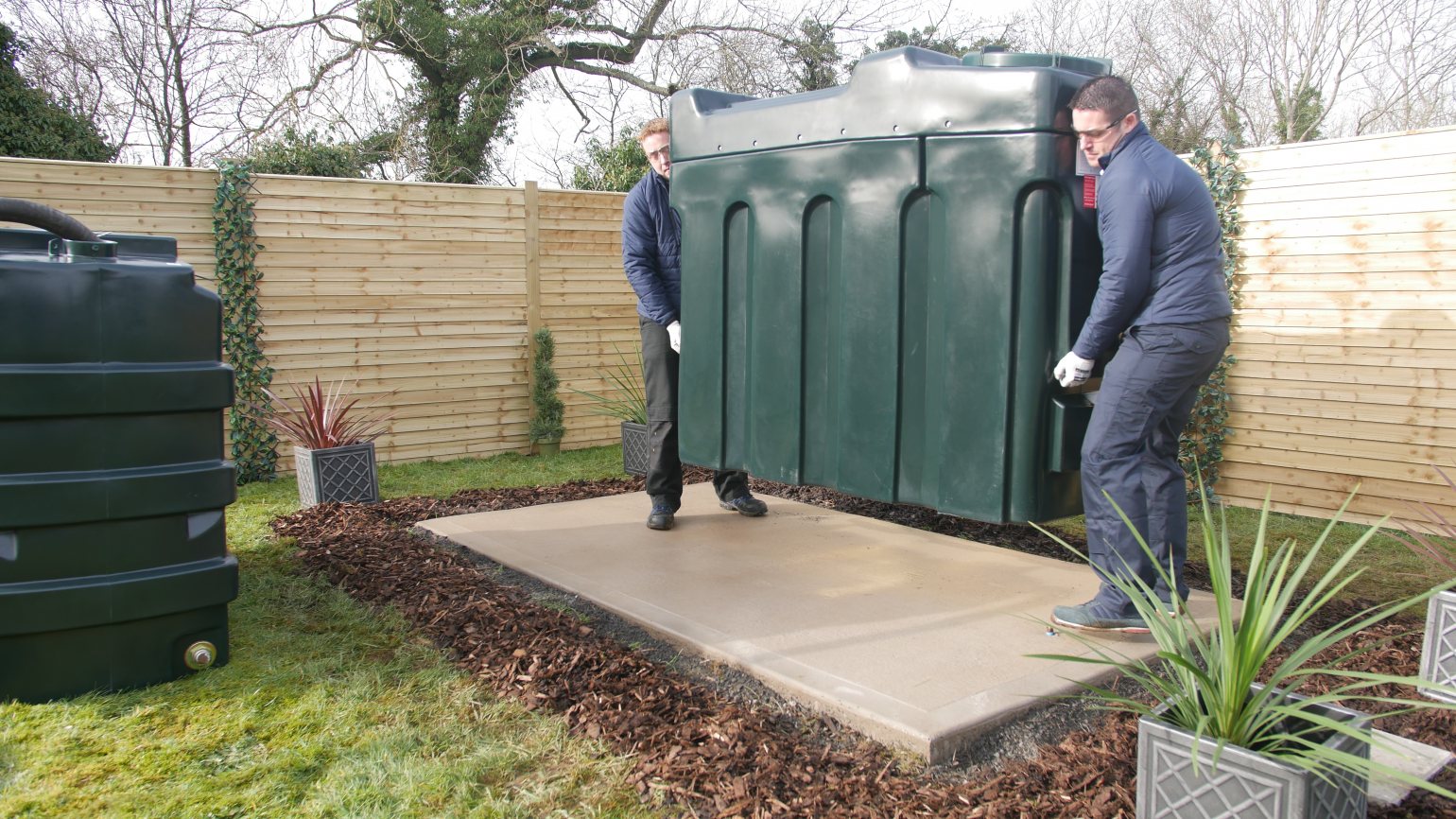

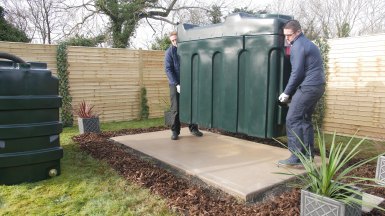
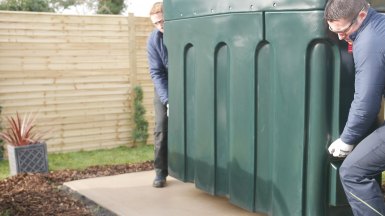
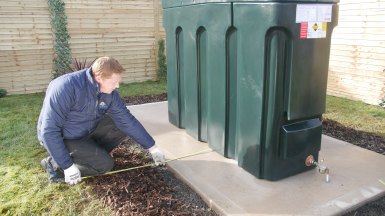
Domestic Oil Tank Installation
We specialise in domestic oil tank installations, offering expert advice to ensure you choose the right tank for your property. Our team can help you determine the ideal size and location for your new tank, based on factors such as household size, heating usage, and available space.
Don’t let an outdated or damaged oil tank disrupt your home comfort any longer. Simply fill out our quick enquiry form, and we’ll ensure one of our recommended installers contacts you within 24 hours. We’re here to provide expert advice and connect you with our trusted installers to ensure your new tank is up and running as quickly as possible. Get in touch now and restore your home’s heating and hot water!
Oil Tank Replacement / Installations Frequently Asked Questions
Oil tanks typically last between 15 and 20 years, depending on the material and maintenance. However, if your tank shows signs of wear, corrosion, or leakage, it may need to be replaced sooner. Regular inspections and maintenance can help extend the lifespan of your tank, but it’s important to replace it before it becomes a safety hazard.
The cost of oil tank installation can vary depending on factors such as the type and size of the tank, location, and the complexity of the installation. It’s recommended to contact an OFTEC-approved installer for a detailed quote. Fuel Tank Shop works with trusted installers who can provide competitive pricing for professional installation services.
Oil tank replacement costs can differ based on the size of the tank, the type (single-skin or bunded), and any additional site preparation required. Replacing an old tank can range from a few hundred to several thousand pounds, especially if a bunded tank is required to meet insurance or environmental regulations. For an accurate estimate, fill out our enquiry form to receive a quote from one of our recommended installers.
To safely dispose of an old oil tank, it’s essential to hire a qualified installer or waste removal service. Free scrap collection is offered as part of our oil tank replacement service. The old tank will be safely removed and responsibly recycled in line with environmental regulations
Bunded oil tanks are designed with an additional outer layer to prevent leaks and spills. Many insurers now require bunded tanks for adequate leak protection, as single-skin tanks may no longer meet coverage requirements. Upgrading to a bunded tank not only enhances environmental protection but also reduces the risk of costly clean-up and repairs.
OFTEC sets the industry standards for oil tank installations in the UK, ensuring safety and compliance. These guidelines include maintaining a safe distance from buildings, using fire-resistant bases, and ensuring proper ventilation. Hiring an OFTEC-approved installer guarantees that your tank installation meets all regulatory standards for safety and environmental protection.
OFTEC Guidelines for Oil Tank Installations
OFTEC (Oil Firing Technical Association) sets the industry standards for oil tank installations in the UK, ensuring safety and regulatory compliance. Key OFTEC guidelines for domestic oil tank installations include:
- Safe Distance: Oil tanks must be installed at a safe distance from buildings, property boundaries, and any potential sources of ignition, such as boilers.
- Fire Barriers: If a tank is too close to a building or boundary, a fire-resistant barrier may need to be installed.
- Base Requirements: Oil tanks should be installed on a stable, fire-resistant base that extends 300mm beyond the tank on all sides.
- Ventilation: Adequate ventilation must be provided to ensure the tank is kept in good condition and to minimise fire risks.
Bunded Tanks: In certain situations, particularly in environmentally sensitive areas, a bunded tank (a tank within a tank) may be required for added protection against leaks.
Tank Base Support
It is important that oil tanks are adequately supported to help prevent any safety concerns and for environmental protection. The base material for your oil tank should be level and either of the following – concrete – at least 100 mm thick, paving stones or stonework – at least 50 mm thick. The OFTEC base construction guidelines are (in brief) –
- Adequate for the weight of the tank when fuel
- Non-combustible, imperforate and level
- Constructed of Concrete, paving stones or stonework
- Large enough to extend 300 mm beyond ALL sides of the tank.
Tank Location
Tanks should be sited, as recommended by OFTEC, to protect them from an ignition source. Tanks should be sited –
- 1.8 m away from non-fire rated eaves of a building
- 1.8 m away from a non-fire rated building or structure (e.g. Garden Shed)
- 1.8 m away from openings (such as doors and windows) in a fire rated building or structure (e.g. brick-built house/ garage)
- 1.8 m away from liquid fuel appliance flue terminals
- 760 mm away from a non-fire rated boundary, such as a wooden boundary fence
- 600 mm away from screening (e.g. trellis and foliage) that does not form part of the boundary.
If it is impossible to comply with the separation distances, then a fire protection barrier (with a minimum of 30 minute fire rating) should be provided. 30-Minutes fire protection enables the installation of an oil tank a minimum of 300 mm from other buildings and structures. Where access is required (e.g. at the front of the tank to fill it) then a minimum distance of 600 mm is required.
However, it is the responsibility of the competent person installing the tank, or the building inspector certifying the installation, to ensure a site-specific risk assessment has been conducted.
Yes, many modern oil tanks come equipped with remote monitoring systems that allow you to track oil levels via a smartphone app. This helps prevent unexpected shortages and ensures you always know when it’s time to reorder oil. Fuel Tank Shop offers a range of tanks with both local and remote monitoring options.
Installing a new oil tank is a detailed process designed to ensure safety and regulatory compliance. Here’s a rough guide to what’s involved:
- Initial Assessment and Survey: Before installation, a qualified installer will assess your site to ensure it meets the necessary safety and access requirements. This includes checking distances from buildings, boundaries, and potential fire hazards, as well as the condition of the ground where the tank will be placed.
- Tank Selection: Based on the survey, the installer will help you select the right tank size and type, considering factors like household size, usage patterns, and available space.
- Site Preparation: The installation site will need to be prepared, which may involve laying a suitable base for the tank. This base must be strong, level, and fire-resistant in compliance with OFTEC regulations.
- Old Tank Removal: If replacing an old tank, the installer will safely disconnect and remove the existing tank. Our partners offer free scrap collection and ensure responsible disposal.
- Installing the New Tank: Once the site is prepared, the new tank will be installed and securely connected to your system. All installations are carried out in accordance with OFTEC guidelines to ensure compliance with safety and environmental standards.
Final Checks and Testing: After installation, the system will be thoroughly tested to ensure it’s operating correctly. The installer will also check that all OFTEC regulations have been met, including tank positioning and safety features.
Read More From Fuel Tank Shop
Watchman Smart Tank Monitoring Systems
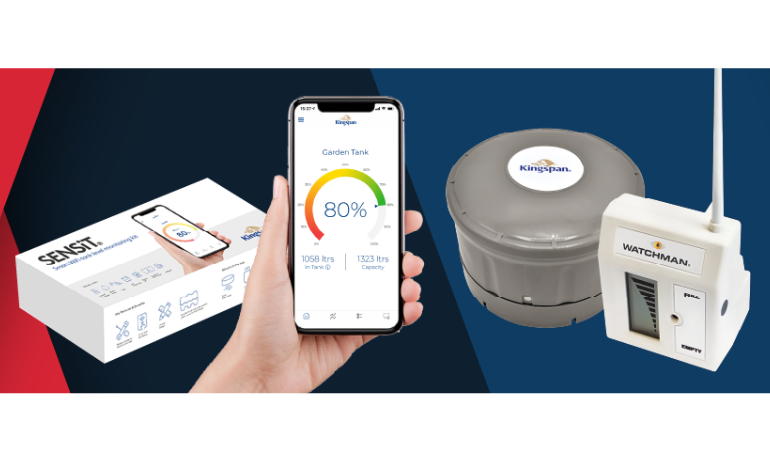
Oil Tank Accessories Explained


 Login
Login